ICM 1/48 Spitfire F. IXA
Remember the days when we Spitfire enthusiasts thought we were in hog heaven with Mk IX releases from Occidental and ICM? Well, that's been almost two decades and a blizzard of Eduard IX/VIII releases later, but here's an ICM Spit I finished back in 2014.
While the story of ICM's Spitfire series was mainly one of what could have been, they were basically good kits with few inaccuracies but inconsistent quality control. That was a shame, because they were fun builds if you knew where to apply 'modeling skills required.'
My F. IX A started life as ICM's LF IXe Czech release with clipped wings, Mk XII rudder and Vokes AeroVee carb intake. I'd picked up the kit around 1998 for about $7 at a model show, and I was wanting to do an early Mk IX, so an Ultracast resin short intake, full wing tips and prop blades to replace the thick kit blades fixed most of those issues. I stole the rudder from a Cooper Details Mk V correction set, and I replaced the somewhat lumpy kit wheels with a spare set from a Tamiya Mk Vb.
The kit suffered from sink marks along the upper and lower wings, but Bondo surfacing putty put those right.
Many are the warnings that the kit's engine firewall and instrument panel are a hair too wide and will induce flat dihedral when you fit the wings. I trimmed them and test fitted the wings, and all was fixed in about ten minutes.
Unless you want an exposed engine, the best route for fuselage assembly is to leave it out and stick up your spares box. Otherwise, assembly was straightforward. The Ultracast parts were drop-fit, and everything aligned.
I didn't want to fiddle with drooped elevators, so I installed a control lock from two pieces of styrene rod - easy and a fun way to drive contest judges up the wall.
Paints are Testor Model Master enamels. Decals are Eagle Editions from their Canadian Spitfires sheet, for Ian Keltie's F. IXA that later became Johnnie Johnson's JE-J. Weathering was done with a combination of pre- and post-shading, artist's oil washes and chalk pastels.
Since I was doing an early Mk IX, I had to rig it with a 'cheese cutter' IFF aerial from the stabilizer tips to the fuselage. I cemented small tabs on the stabilizer tips, drilled them out with a no. 80 bit, and drilled the fuselage lead-ins with a no. 78 bit.
I then carefully cemented the end of a long length of monofilament sewing thread to a section of thin brass wire. I threaded that through the fuselage holes after a bit of blind probing, removed the wire, and tensioned and secured each end to the stabilizers.

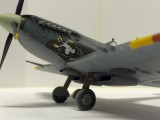

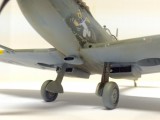
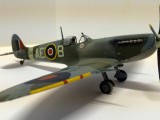
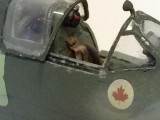
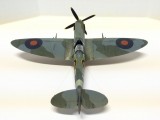

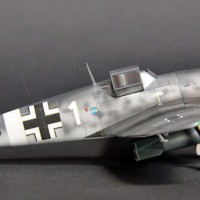

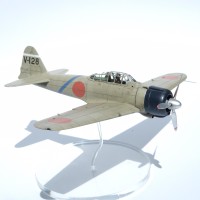
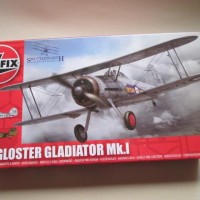
Still, a good result.
Looks good, Mike...I like your antenna attaching method. 🙂
Thanks. It sounded scary when I thought up the idea, but it worked pretty well. Kind of like hitting the one-meter exhaust port on the Death Star lol.
I built the Occidental Mk. IX when it first came out and have an MPM rebox as well as an ICM Spitfire in the stash. Yeah, what you say about these kits is true, but I still think they are very underated kits. ICM especially gives the modeler a lot of bang for the buck. Nothing wrong with your results. Very well done.
Thanks, I've got an Italeri/Occidental in the almost finished pile - all you have to do is raise the thrust line 1/16" and shim up the cowling and that fixes the nose shape nicely. Everything else in that kit is pretty presentable except maybe for a few issues on the decals.
Like
I like it Mike, well done. Always enjoy a nice spit, and this one is very nice.
Great-looking Spit - you do excellent detail and finish/shading/chipping work on your models.
Excellent result from this kit !
Very nice Mike! I got rid of some ICM Spitfire kits when I was trying to get control of my stash...but regret it. I think they are getting the recognition they deserved.
Very nice. I still have a few ICM kits to build (mostly Spits)but have found that there are very few problems with them. Currently building the P-51B.
Lovely Spit! I really like the ICM Spits, almost as much as the (much more expensive) Eduards.
Very nice paint and weathering, too. And a 402 (City of Winnipeg) Squadron, to boot!